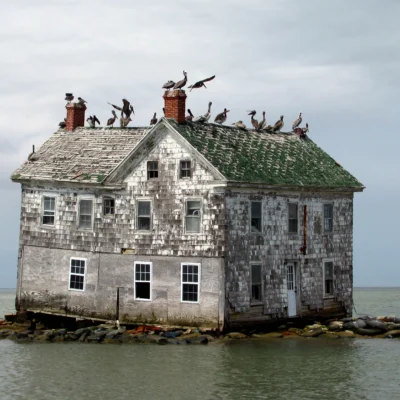The Trans-Allegheny Lunatic Asylum, located in Weston, West Virginia, stands as a haunting reminder of the dark history of mental health care in the United States. Originally opened in the mid-1800s, the asylum’s imposing structure and tragic history have earned it a reputation as one of the most notorious and haunted locations in the country. Today, the asylum draws visitors from around the world, both those interested in its chilling past and those seeking to explore its paranormal reputation.
A Glimpse Into the Past: The History of Trans-Allegheny Lunatic Asylum

The Trans-Allegheny Lunatic Asylum was founded in 1858 and was intended to provide a place of care for the mentally ill, at a time when mental health treatment was often misunderstood and severely lacking. The asylum’s original design was based on the Kirkbride Plan, a method developed by psychiatrist thomas Szasz Story Kirkbride. His vision was to create an institution that allowed for natural light, ventilation, and space for patients, believing these factors could help promote recovery.
The asylum was constructed in several phases, with the final building completed in 1881. The massive Gothic-style structure, which is made of sandstone, became one of the largest hand-cut stone buildings in the U.S. and was intended to house up to 250 patients. However, due to overcrowding and lack of funding, the asylum quickly became a nightmarish place for its inhabitants. By the early 1900s, the number of patients had ballooned to over 2,400, far surpassing the facility’s intended capacity.
As a result, the quality of care rapidly deteriorated. Patients were often subjected to overcrowding, harsh treatments, and inadequate care. Electroshock therapy, lobotomies, and other invasive treatments were used to treat mental illnesses, often without consent or understanding of their long-term effects. Many of the patients in the asylum were not mentally ill in the way we understand today, and many were admitted for reasons such as poverty, domestic violence, or even political disagreements.
A Dark Reputation: The Haunted History of Trans-Allegheny Lunatic Asylum
By the mid-20th century, the conditions at the Trans-Allegheny Lunatic Asylum were deplorable. The building became a symbol of the failures in the treatment of mental health, and as overcrowding and neglect continued, the asylum’s reputation darkened. The facility became a place of fear, both for the patients and for the staff. Numerous reports of violence, abuse, and suffering emerged from within the walls of the institution, leaving a lasting impact on the building’s history.
The asylum’s reputation as a haunted location grew over the years, and it became a focal point for those interested in the paranormal. Many believe that the spirits of the patients who suffered within the asylum’s walls still linger in the building today. Some say that the building’s dark past has created a sort of spiritual imprint that attracts negative energy, which is responsible for the strange phenomena reported by visitors.
Ghostly Encounters: Paranormal Activity at the Asylum
Over the years, the Trans-Allegheny Lunatic Asylum has gained fame for its paranormal activity. Visitors, ghost hunters, and even former staff members have reported a wide variety of eerie occurrences during their time at the asylum. The most commonly reported experiences include hearing unexplained footsteps, doors opening and closing on their own, and the sound of children laughing, even though no children are present.
One of the most famous paranormal reports involves the ghost of a woman named Ruth, believed to be a former patient who died under mysterious circumstances. Visitors to the asylum have reported feeling her presence, particularly in the psychiatric ward, and some have claimed to see her apparition, wandering the halls. Others have heard her voice or felt an unexplained cold spot where she is said to have died.
Another well-known apparition is that of a former staff member, who allegedly haunts the building’s third floor. Staff members who worked in the asylum during its final years of operation reported hearing strange noises and feeling watched while working in the area. The third floor, which housed some of the most severely disturbed patients, has long been considered a hotbed of paranormal activity.
Many paranormal investigators have visited the Trans-Allegheny Lunatic Asylum over the years, some with equipment designed to detect spirits. Devices such as electromagnetic field (EMF) detectors, infrared thermometers, and spirit boxes have been used in an attempt to communicate with the ghosts said to haunt the asylum. Some investigators have reported capturing evidence of strange voices and unexplained figures on camera, while others have experienced a sense of unease or dread during their investigations.
The Legend of the “Devil’s Chair”
One of the most famous locations in the Trans-Allegheny Lunatic Asylum is the so-called “Devil’s Chair,” a particular spot in the building where visitors claim to experience extreme paranormal activity. The chair is located in one of the asylum’s old wards, and it is said to be cursed. Those who sit in the chair or approach it report feeling an overwhelming sense of fear or even physical discomfort, such as nausea or dizziness. Some believe that the chair is a portal for spirits, and that the energy of the building channels through it.
The “Devil’s Chair” has become a point of fascination for ghost hunters and thrill-seekers, and many have attempted to capture evidence of the supernatural while sitting in the chair. The legend surrounding this chair only adds to the asylum’s eerie mystique, making it a must-see for anyone interested in the paranormal.
The End of an Era: Closing the Doors of Trans-Allegheny Lunatic Asylum
The Trans-Allegheny Lunatic Asylum was officially closed as a psychiatric institution in 1994. After nearly a century and a half of operation, the facility was abandoned and left to decay, though its haunted legacy continued to grow. Since its closure, the building has remained largely empty, save for the occasional group of ghost hunters or curious tourists.
In 2007, the Trans-Allegheny Lunatic Asylum was officially opened for tours. The site offers a variety of tours, ranging from historical walks that explain the asylum’s tragic past to ghost tours that focus on its haunted reputation. Visitors can explore the building’s many rooms, including the former wards and isolation cells, and get a firsthand look at the asylum’s eerie and decaying interior.
A Place of History and Haunting
Today, the Trans-Allegheny Lunatic Asylum is both a historical landmark and a center for paranormal investigation. While its tragic past cannot be erased, the building offers visitors a chance to explore the evolution of mental health care in America and the human toll that often accompanied these early treatments.
Despite its haunting reputation, the asylum’s restoration efforts have made it a significant part of Weston’s historical landscape. For those brave enough to visit, it’s a place where history and the paranormal intertwine, leaving a lasting impression on anyone who steps into its dark and eerie halls.
Final Thoughts
The Trans-Allegheny Lunatic Asylum stands as a testament to the dark side of mental health care, but it is also a place of history, mystery, and haunting. With its chilling tales of suffering and death, it is no surprise that it has become a hub for paranormal activity. Whether you are drawn to its history or its ghosts, the asylum remains a place where the past lingers and where the spirits of those who lived and died there are said to still haunt the halls.
A visit to the Trans-Allegheny Lunatic Asylum is not just a tour through a crumbling building, but a journey into the heart of a troubled past and the spirits that may still haunt it today.
Who Is Clete Blakeman? The NFL Referee With a Surprising Past






